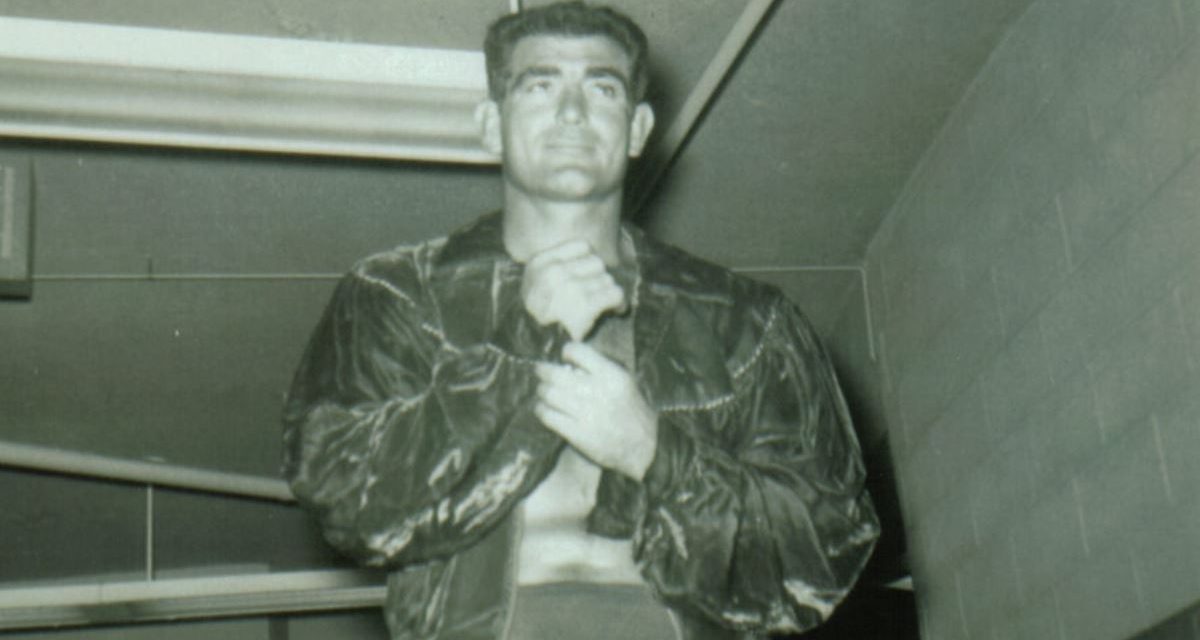There is no Wikipedia entry on Joe Blanchard, who died March 22, 2012, at the age of 84. Perhaps that is a testament to a gentleman who didn’t brag despite a myriad of accomplishments: A Big 7 wrestling champion at Kansas State, a Grey Cup loss with the Edmonton Eskimos’ CFL team, a 25-year pro wrestling career, and a San Antonio-based wrestling promotion that briefly had a chance at a national run. To top it off, his son Tully Blanchard, became a major wrestling star in his own right.
In the couple of conversations this writer had with Blanchard over the years, the stories he shared were almost exclusively about other people, those he played football with, wrestled with, or had on his wrestling cards.
Born in Oklahoma in 1928, Blanchard was a high school football star in Parsons, Kansas, and grew into a 6-foot, 225-pound stud of an athlete. At Kansas State College, he played football but excelled in amateur wrestling.
At the 1950 NCAA tournament, Blanchard entered as the Big 7 champion, having beaten defending champion Mike Dibiase of Nebraska (father of Ted “The Million Dollar Man” DiBiase) by referee’s decision, and was seeded fourth. He lost to Richard Simmons of Wheaton in his first tournament match at Northern Iowa.
After graduation, Blanchard headed north to the CFL’s Eskimos — not an uncommon trip in the day when the CFL often paid better than the NFL. He would play three seasons in Edmonton.
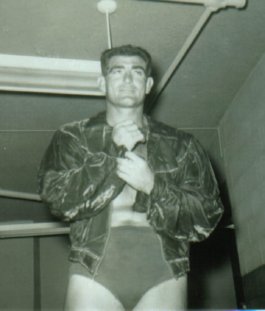
Joe Blanchard in the 1950s. Photo courtesy Dr. Bob Bryla
Al Oeming was the “Boy Promoter” in Edmonton, and saw three of the Eskimos of that era go on to long pro wrestling careers: Blanchard, Wilbur Snyder and Gene Kiniski.
“He was always a reserved, quiet, humble fellow, never put on any airs — just a pleasure to be around,” Oeming said of Blanchard. It was natural to compare Snyder and Blanchard, said Oeming. “They were both well built, good-looking, Snyder particularly, tall, blond. Snyder had a bit of show savvy. Joe was a little laid-back and quiet, didn’t have quite the charisma to rev up the wrestling audiences. They had a few matches here and then they went on to other circuits.”
Both Snyder and Blanchard balanced pro wrestling and pro football for a time, mainly working around Edmonton.
“They both were popular with the football team, and that played over to the wrestling too. Mind you, they didn’t have a lot of experience in professional wrestling, and they were competing on cards with some pretty big names, guys that were automatic sellouts anytime they showed up,” said Oeming, adding that in their early matches “they could call on their football background.”
“It was a great group of guys, fine coaches. I had nothing but great experiences up there,” Blanchard said of his time in Edmonton in 2006. Edmonton is also where he met his future wife, Jackie, with whom he would have two sons.
In the 1952 season, the Eskimos made it to the 40th Grey Cup, losing to the Toronto Argonauts, 21-11, at Varsity Stadium in Toronto.
Devoting his time to wrestling, Blanchard drew initial publicity from his time in Indianapolis.
“Blanchard is many steps ahead of most football players who move into pro mat ranks. He isn’t a football player turning wrestler. He is a wrestler who became a football player and is now going back to wrestling,” reads WRESTLING U.S.A., dated November 1954.
An early mentor was Warren Bockwinkel. “Once in a while you come across a youngster who sticks out head and shoulders above the rest. He has the build and the speed and you figure to yourself you would like to take him in hand and teach him the skill that would make him really good,”|Bockwinkel said in the article. “That’s how I felt the first time I saw Blanchard. There was one big difference, however. I found there wasn’t much need for me or anyone else to take him in hand … he already had plenty of real skill.”
Warren Bockwinkel’s son Nick, the future AWA World champion, teamed a lot with Blanchard in Indianapolis.
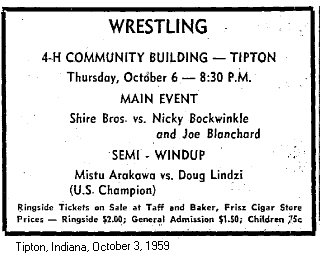
“[We] were a tag team against the Shire Brothers back in Indiana when [Jim] Barnett had that territory. The Brunetti Brothers were there too. They were probably half a notch or two above us because they were both Italian, so they had the ethnic thing. Joe Blanchard and I were two good babyfaces,” recalled Nick Bockwinkel.
One of “Jolting” Joe Blanchard’s favorite territories was Hawaii, where Al Karasick was the promoter.
“Al was a little Jewish guy who ranted and raved, and was a nice man. He wasn’t a bad guy to work with,” Blanchard said. The wrestlers would work in Honolulu once a week, and occasionally did shows at an army barracks, or an outer island.
“He paid us, and we were there on a guarantee. It was a living and a chance to see Hawaii. We had a good time over there,” Blanchard reminisced. “My wife and I, and we had one son then. Tully was a little boy then, and, praise the Lord, we all learned to surf, paddle canoes. We had a good time over there. It was really a wonderful time. I spent seven months over there once, and three months another time.”
In a 1971 article in the San Antonio Light, Blanchard listed the places the family was stationed. “We lived in Hawaii twice, in California, Buffalo, N.Y., Kansas City, Houston, Indianapolis and Dallas before we came to San Antonio.”
San Antonio would become home to the Blanchard family, and Joe would buy the local promotion in the 1960s. Much of his promotional savvy came from his time in Indianapolis.
Blanchard worked in the office in Indianapolis from 1959 to 1963 with Barnett and Balk Estes, who was his partner. “I was just working wrestling and later started doing the television show. But I worked there in the office and helped book and helped run the thing. We were doing live television shows at that time. It was before videotape and we had five live television shows a week, which were studio shows. We had one in Ft. Wayne, Indiana, and Elkhart, Indiana, and then Cincinnati and Detroit and Indianapolis, and at one time Louisville. We were busy doing studio shows as well as running house shows.”
The Indianapolis promotion had a good crew, said Blanchard, listing Dick the Bruiser, Wilbur Snyder, Cowboy Bob Ellis, Johnny Weaver, and The Sheik. “We had a good group of guys and produced a lot of income. We went into Omaha one time and into St. Louis for Muchnick. We worked back and forth with [Verne] Gagne and he worked back and forth with us.”
Blanchard’s territory worked in partnership with Fritz Von Erich’s Dallas end, and Paul Boesch in Houston, during the 1960s and 1970s. The promotions would share talent, but each area would have to cater to its respective audiences.
For Blanchard, so close to the Mexican border, it was a heavily Hispanic population.
“[Jose] Lothario, [Mil] Mascaras, Rito Romero, they were all fine guys, fine Mexicans, fine stars, fine wrestlers. They were good,” Blanchard rhymed off in December 2010. “There were a lot of guys that came up here from Mexico before these guys, Ricky Romero, Blackie Guzman, El Santo. These guys were superstars from Mexico. Of course, when they started making television down there, it played up here on Mexican television stations. You could bring these guys in and it was instant here in San Antonio, where we have 60% Mexican population. Why these guys were instant money.”
Von Erich (Jack Adkisson) and Blanchard were money together in the ring and fought often.
“He was a good hand. He was a good athlete and a good hand. I’ve got nothing but good things about Fritz. He worked hard and was diligent to the business. He tried to do good,” said Blanchard.
However, Von Erich and Blanchard didn’t always see eye to eye on promoting, and Blanchard didn’t book their stuff that often. “I didn’t like their people. Not very many people could get over. San Antonio is a different thing. There’s a big Mexican population here, it’s different. You’ve got to do it different.”
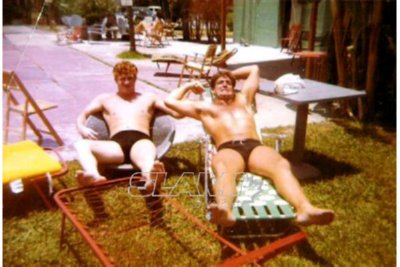
Red Bastien and Joe Blanchard relax in 1957.
Besides being a smart promoter, Blanchard had a nose for talent. In Hawaii, he befriended Curtis Iaukea and helped get him into pro wrestling.
“He hung around the beach with us. He was a big, good-looking guy. He wasn’t 350 pounds then, he was 260 with a 34″ waist, and looked great. He had been playing football. He played up in Canada one year. You just start talking to people on the beach and you get acquainted. We started going surfing together. He became a friend,” said Blanchard.
Wahoo McDaniel was also a Blanchard protege, and it was Wahoo who steered Blackjack Mulligan to Blanchard to start wrestling as well.
Blanchard explained how Wahoo ended up in pro wrestling. “We used Don Eagle and Don Eagle left and he died not long after. So Balk was sitting in the office, he and Jim and I, and Jim says, ‘We need a new Indian.’ And Balk says, ‘Well, there’s an Indian just graduated from the University of Oklahoma named Wahoo McDaniel and he was an All-American football player and why don’t we try to get him?’
Estes had gone to the University of Oklahoma, and eventually they tracked Wahoo down — he was a welder in Midland, Texas. When Wahoo was flown to town, it was Blanchard who was dispatched to the airport to get him. “I guess I was the first wrestler he ever met. … I don’t know what kind of deal he got. We started him, worked out a little bit with him, booked him. He really had a good talent and was really ambitious.”
The split between the three Texas promoters was, in part, as a result of children. Von Erich wanted to push his sons, and Boesch was a big supporter of Gino Hernandez. Blanchard’s son, Tully, started at SMU and ended up as a wishbone quarterback at West Texas State from 1974 to 1976, and was ready to wrestle as well. (Another Blanchard son, Taylor, had died when he was a teenager.)
“Some guys can draw money, and some guys can’t. Your whole philosophy in the wrestling business is to put butts in the seats. Johnny Valentine could do it. My son Tully could do it, even when I was the promoter and everybody liked me, they hated him; just walking out of the dressing room they hated him. He could draw money. Wahoo was booking here and tried to make him a babyface and I said, ‘We’ve got to switch him heel.’ Houses jumped quadruple the first day we switched him heel. He could put people in the seats. He drew money,” summed up Blanchard.
It is hard to pinpoint who will be successful, Blanchard admitted: “You can’t tell what it is. They do the same things that other people do, maybe they do them a little better, more realistic or something, but they put people in the seats.”
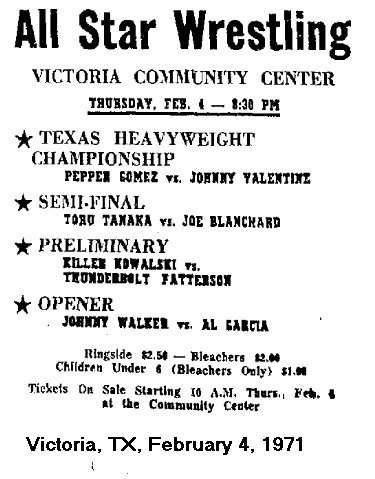
In 1978, Blanchard started promoting his company as Southwest Championship Wrestling, breaking from Von Erich’s Southwest Sports, Inc. The TV show, taped at the Junction, with bigger shows at the Hemisphere Arena, were violent compared to the traditional wrestling that had been on the air. As cable TV started, Blanchard’s SCW ended up on the USA Network.
With a top flight television taped at the Junction and major shows at the Hemisphere Arena, the “Southwest” group, for most of its run a member of the National Wrestling Alliance, was one of the more creative and violent groups of its era, with Blanchard often as an announcer.
The first promotion to run a weekly show on the USA cable network, the promotion broke apart in 1985 following a power struggle between founder Joe Blanchard and business associate Fred Behrends.
On the KayfabeMemories board, Chuck Merkich recalled the glory days of the promotion, which drew fans for its creativity while WWF was taking off nationally as a cartoonish entity. “SWCW soon became one of the hottest wrestling regions in the game. It was extreme long before the term became common place in wrestling. Working relationships with both Houston and Georgia wrestling were able to generate enough excitement and popularity that in 1983 they became the first wrestling program to be aired on the USA network. It would soon become the number one rated show on the station. With close to national exposure, SWCW sponsored a tournament to crown an undisputed world heavyweight champion. I assume it was done to show that they were a major player. An eight man tournament was held on May 26,1983 in Houston, Texas with the late Adrian Adonis emerging as the winner. The championship would not be accepted by the rest of the wrestling world and was abandoned four months later. SWCW continued presenting some of the highest quality cards that have yet to be equaled to this day.”
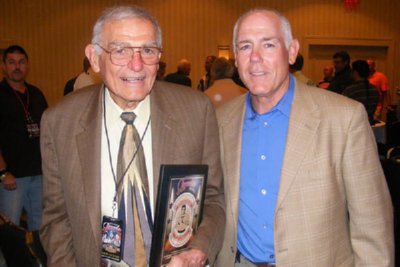
Joe and Tully Blanchard at 2010 Hall of Heroes banquet in Charlotte. Photo by Christine Coons
Things didn’t work out for Blanchard, at least not on a national level. He was aware of the value of his slot on USA Network said Johnny Powers, who had promoted the Cleveland to Buffalo corridor and the IWA in North Carolina.
“Do you know that I actually flew down to meet Blanchard and was trying to negotiate that USA spot? But I couldn’t come up with the full funding, financing that I thought I needed, which was at least 39 weeks. I felt I needed at least three cycles. But I flew down to San Antonio, Texas, and talked to Blanchard about that spot,” said Powers.
Blanchard was forced to sell the USA Network timeslot, and Vince McMahon’s Titan Sports swooped in, beginning a true national expansion of the WWF beyond its syndicated stations. Behrends did a work-around behind Blanchard’s back, giving the San Antonio English TV spot to Von Erich’s World Class Championship Wrestling.
For the most part, Joe Blanchard stayed out of the wrestling business after his promotion shut down. He was a figurehead president of the AWA in 1989 after Stanley Blackburn.
Deeply religious, Blanchard would work at San Antonio’s Cornerstone Church. His son, Tully, cleaned up his notorious partying ways and became a preacher. When their longtime friend Wahoo McDaniel was near the end of his life, the Blanchards flew up to North Carolina to pray with him.
The father-son combo had always been close, with Joe coaching Tully in football and shaping him for college ball. “We (Joe and Tutly) work with weights about three days a week during the summer and run quite a bit,” Joe said in 1971. “I’ve always thought that a college scholarship was worth more than whatever money Tully could earn during the summer. Fortunately we haven’t needed for him to work so he’s been able to devote the summers to football.”
Today, Tully Blanchard posted notice of his father’s passing on Facebook: “3-22-2012 marks the end of my Father’s life in the natural. He passed at 8:00 AM, Joe Blanchard stepped into Eternity with his Lord and Savior, Jesus!”
Joe and Tully appeared together at the 2010 NWA Wrestling Legends Fan Fest in Charlotte, and Joe was inducted into the Hall of Heroes.
“Dory Funk Jr. helped us induct Mr. Blanchard into our Hall of Heroes here in Charlotte back in 2010. That same weekend, he and son Tully shared their testimony at our Sunday morning worship service. For those of us that were there, we heard a powerful testimony of a great Christian gentleman. I feel honored to have had him part of our weekend, and I ask each of you to join me in praying for strength for his family and friends,” recalled Fan Fest promoter Greg Price on Facebook.
— with files from Steven Johnson
RELATED LINK
